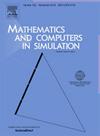Dynamic analysis of Hashimoto’s Thyroiditis bio-mathematical model using artificial neural network
IF 4.4
2区 数学
Q1 COMPUTER SCIENCE, INTERDISCIPLINARY APPLICATIONS
引用次数: 0
Abstract
This article establishes an efficient solution scheme for a mathematical model of Hashimoto’s Thyroiditis (HT) employing artificial neural networks. HT is an auto-immune disorder hostile to the thyroid follicle cells, effectuating hypothyroid or hyperthyroidism. Under this condition, the thyroid-stimulating hormone (TSH) alters incomparably to the free thyroxine (FT4) interrupts the functioning of the hypothalamus-pituitary-thyroid (HPT) axis, implicating the thyroid follicle cells getting destroyed. We primarily focus on utilizing artificial neural network (ANN) to perform numerical simulations for the system of ordinary differential equations describing the dynamics of an existing 4D model of HT. The presented model comprises four time-dependent variables: TSH, FT4, anti-thyroid antibodies (Ab), and size of the thyroid gland (T). We utilize ND-Solver and ANN scheme in the Mathematica software to acquire the computational data and illustrate thus retrieved results with essential performance plots. Further, mean square error has been considered in validating the proposed ANN-based approach accurately. The plot for training and validation loss exhibits the effectiveness of the proposed methodology, and substantiate that the suggested ANN approach is a good fit for the solving the mathematical model of HT.
利用人工神经网络对桥本氏甲状腺炎生物数学模型进行动态分析
本文利用人工神经网络建立了桥本氏甲状腺炎(HT)数学模型的高效求解方案。桥本氏甲状腺炎是一种敌视甲状腺滤泡细胞的自身免疫性疾病,可导致甲状腺功能减退或亢进。在这种情况下,促甲状腺激素(TSH)与游离甲状腺素(FT4)会发生巨大变化,从而干扰下丘脑-垂体-甲状腺轴(HPT)的功能,导致甲状腺滤泡细胞遭到破坏。我们主要侧重于利用人工神经网络(ANN)对描述现有 HT 四维模型动态的常微分方程系统进行数值模拟。该模型由四个随时间变化的变量组成:TSH、FT4、抗甲状腺抗体(Ab)和甲状腺大小(T)。我们利用 Mathematica 软件中的 ND-Solver 和 ANN 方案获取计算数据,并用基本性能图说明检索结果。此外,我们还考虑了均方误差,以准确验证所提出的基于 ANN 的方法。训练和验证损失图显示了所建议方法的有效性,并证明所建议的方差网络方法非常适合 HT 数学模型的求解。
本文章由计算机程序翻译,如有差异,请以英文原文为准。
求助全文
约1分钟内获得全文
求助全文
来源期刊

Mathematics and Computers in Simulation
数学-计算机:跨学科应用
CiteScore
8.90
自引率
4.30%
发文量
335
审稿时长
54 days
期刊介绍:
The aim of the journal is to provide an international forum for the dissemination of up-to-date information in the fields of the mathematics and computers, in particular (but not exclusively) as they apply to the dynamics of systems, their simulation and scientific computation in general. Published material ranges from short, concise research papers to more general tutorial articles.
Mathematics and Computers in Simulation, published monthly, is the official organ of IMACS, the International Association for Mathematics and Computers in Simulation (Formerly AICA). This Association, founded in 1955 and legally incorporated in 1956 is a member of FIACC (the Five International Associations Coordinating Committee), together with IFIP, IFAV, IFORS and IMEKO.
Topics covered by the journal include mathematical tools in:
•The foundations of systems modelling
•Numerical analysis and the development of algorithms for simulation
They also include considerations about computer hardware for simulation and about special software and compilers.
The journal also publishes articles concerned with specific applications of modelling and simulation in science and engineering, with relevant applied mathematics, the general philosophy of systems simulation, and their impact on disciplinary and interdisciplinary research.
The journal includes a Book Review section -- and a "News on IMACS" section that contains a Calendar of future Conferences/Events and other information about the Association.
 求助内容:
求助内容: 应助结果提醒方式:
应助结果提醒方式:


